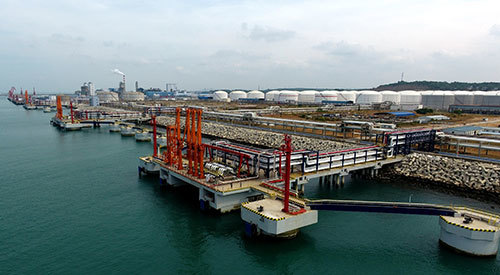Reflection on Group Informationization Construction
Release time:
2020-07-30
Reflection on Group Informationization Construction
As a leading enterprise in the installation industry in Jiangsu, the informationization construction of the group should be positioned at a high level, with a long-term perspective, adhere to overall planning and step-by-step implementation, not only in line with the enterprise management system, but also to improve management quality and efficiency, and assist in high-quality development. This requires us to make overall thinking and strategic layout for the informationization construction of the group in the specific implementation process, and carry out hierarchical planning and construction for the informationization terminal performance layer, management system application layer, tool software application layer, basic technology platform layer, and informationization infrastructure layer. Information construction is not just about purchasing software, but also requires the establishment of supporting systems, the guarantee of capital investment, and the support of standardized process systems. It also requires the cooperation of organizational departments to customize and develop information management systems that meet the characteristics of Qi'an management.
1、 Qi'an's Core Informatization Application Architecture
The construction of information technology requires comprehensive planning and close attention to the core business of Qi'an. According to Qi'an's own needs, carry out information construction in stages and selectively. Each activity on the value chain has a different impact on how much value the enterprise can ultimately achieve. The improvement of core business activities on the core value chain has the greatest impact on the value creation of the enterprise. In addition, the improvement of auxiliary activities that affect the core value chain will also have a significant impact on the value creation of the enterprise. Therefore, Qi'an's focus on information application architecture should revolve around core business activities, helping enterprises create greater value through management improvement and information implementation. Specifically, the focus of information application architecture should meet the core value proposition: with project management as the core and operational control as the support, achieving enterprise intensive management, project lean management, improving production efficiency, and enhancing management efficiency.
(1) Portal Unified Portal
The unified portal layer provides services for the "customer terminal presentation layer" in the overall architecture. Generally speaking, it provides business system portal integration services, specifically manifested as the underlying framework structure of enterprise portals, mobile portals, instant messaging micro portals, and intelligent client applications.
The unified portal layer also provides scalable portal websites, and business modules can access the portal website as long as they follow the portal standards, achieving unified access to business systems. The unified portal layer provides unified identity authentication services for website login and instant messaging login, so no matter which application, single sign on can be achieved through the presentation layer.
(2) Technology Platform
The main task of the technology platform is to provide services and interfaces for business systems. Qi'an's technology platform summarizes and extracts the common functions or data required by application systems, and opens them up through API for application module calls. This not only avoids resource waste caused by repetitive development, but also ensures the consistency of business logic between different applications.
The Qi'an Technology Platform also provides a toolset to meet the scalability, adaptability, and flexibility of enterprise information construction. Provide platform management tools to meet the organizational permission management needs of enterprises. Provide business development tools to support large-scale business application development. Provide business implementation tools that can quickly meet most personalized configuration needs. Customers can also use development and implementation tools for business customization. Enhance the maintainability of specific businesses. Based on the business characteristics of Qi'an, the Qi'an technology platform adopts the SaaS deployment model.
(3) Management system application layer
The application layer is an organic combination of various information systems, directly carrying the implementation of Qi'an's management system and processes. Carrying the implementation of the management concept of "enterprise intensive management and project lean management", we support the core business from three levels: strategy, operation, and project. And according to the specific management mode and characteristics of Qi'an, corresponding configurations and adjustments will be made to meet the needs of core business management.
◆ OA office system
The OA system is a platform for collaborative work, information exchange, and communication coordination at Qi'an. Collaborative office systems start from three aspects: information transmission, process execution, and knowledge accumulation. Realize collaborative work within enterprises and organizations, thereby improving work efficiency, driving them to standardize their work and behavior according to processes and systems, improving their administrative execution, and supporting the implementation of strategic goals.
◆ Human resource management system
Putting people first is the driving force for sustainable development of enterprises, and selecting, employing, educating, and unleashing people's enthusiasm is crucial. Enterprises need to grasp personnel dynamics and provide human support for project management to ensure the normal operation of production. The basic functional modules of the Qi'an Human Resources Management System include recruitment management, personnel management, certificate management, training management, salary management, performance management, and other modules. Establish a basic information database for the entire group's personnel to provide services for talent planning and allocation. Establish a performance evaluation system and strengthen the overall coordination of personnel management in enterprises. Improve the efficiency of enterprise human resource management through informatization and standardize the human resource management process.
Market operation management system
Through the application of market operation management system. Comprehensive management of project tracking, bidding process, customer relationship, and competitive analysis. Qi'an's marketing personnel are able to maintain information on the dynamics of owners, partners, and competitors, track project filing and update information, conduct comprehensive analysis and decision-making review of bidding, dynamically track and manage the bidding process, formulate contract strategies, and summarize after bidding. Establish the company's marketing database to provide reference for future bidding work on similar projects.
Cost management system
According to the basic principle of "two lines of income and expenditure, with fixed income and expenditure", the comprehensive budget of the project is used as the benchmark for fund management control, the fund plan is used as the control method, and the actual payment of the project is used as the control unit. The centralized fund control system is mainly adopted, supplemented by the information management system, to achieve centralized management of fund business within the Qi'an Group.
By establishing a budget and fund management system, establish a comprehensive budget management, rolling budget, fund planning, settlement control, actual payment control, and cost accounting one-stop fund control system for the project. Effectively control the use of project funds.
◆ Financial management system
Realize the concentration of enterprise financial data, ensure the unified financial internal control system, accounting system, accounting process, basic files, bill management, etc. of the enterprise, achieve real-time monitoring of financial data and information, and support the management of basic financial accounting, fixed assets, inventory, accounts receivable, payable costs, funds, and other businesses of the enterprise. Establish a unified report management platform to achieve real-time, accurate, and flexible data statistics. By building a comprehensive information and statistical platform based on an indicator system for reporting, statistical analysis, and data publishing, we can achieve data statistics, query and analysis for any period, multi-level units, and multiple types within the reporting system. The key issue to consider during system construction is the interface between the financial system and other business systems.
◆ Archives management system
The archive management system is a comprehensive information management system for engineering and document archives of enterprises, mainly solving the problem of computer-aided application in the entire process of archive management, realizing the automation of archive business management process, improving the timeliness and scientific management level of archive work, as well as the development and utilization level of archive resources. From the perspective of business scope, it covers all aspects such as collection and archiving, organization and cataloging, archive storage, archive statistics, and borrowing and utilization. From the perspective of purpose, it covers data entry, file grouping, file adjustment, data statistics, report output, and other aspects. Covering all departments of the enterprise and project in terms of application scope.
◆ decision analysis System
This mainly includes systems such as business planning and budget management, strategic management, internal control management, organizational performance management, and decision support analysis. Develop strategic goals and decompose them, and issue business indicators in accordance with business plans and budget management. Extract data from various business systems through business intelligence, establish analysis themes, mainly from dimensions such as project distribution, enterprise profits, output value, cost status, funding status, operational status, risk analysis, etc., apply data mining, drilling, tracing, and other methods, and present the analysis results to the management decision-making layer through friendly graphics and reports to support scientific decision-making and organizational performance management, and achieve strategic goals.
◆ Other basic operating systems
Other systems that support core business operations. For example, smart construction sites, administrative offices, legal management, party building management, etc.
(4) Terminal usage layer
To achieve comprehensive information construction, Qi'an must pay attention to the application issues at the construction site, effectively solve the information exchange problem between on-site personnel and IT systems, in order to ensure timely and accurate data sources. By receiving backend information through terminals such as laptops, mobile phones, smart devices, and video surveillance, frontline managers can easily obtain the necessary information, meeting the characteristics of "mobile management" on project sites. By using mobile applications, RFID, video surveillance, on-site construction records, and other "input" information to the backend server, the accuracy and timeliness of frontline data acquisition are ensured, laying the foundation for further processing and analysis of data in the later stage.
2、 Basic Principles of Qi'an Informationization
The construction of information technology in Qi'an is a relatively complex implementation process. At the macro level, it is necessary to correctly position the current situation and capabilities of enterprise information technology, and formulate a practical and feasible information technology construction route; At the micro level, it is necessary to start from the management process, organizational structure, and technical level of the enterprise itself, and achieve management innovation and upgrading through process reengineering. At the same time, the informatization construction of Qi'an is a planned organizational change, which means that the enterprise needs to operate in a new way and will involve all aspects of the enterprise. In the process of informationization construction, various problems may arise. It is not achieved overnight, but rather a long-term iterative and spiral process. Therefore, the process of information construction in Qi'an needs to follow scientific principles, generally speaking, it is "centered around industry characteristics and closely adhering to the four basic principles".
(1) Meeting enterprise development strategies
Before the construction of information technology, the ability of Qi'an's information technology was evaluated from two levels.
Firstly, the overall level of enterprise informatization is analyzed and evaluated from five aspects: the purpose of information system construction, the scope of information system application, key technologies of informatization, the level of information management and control, and the level of information participation of enterprise users, in order to determine the stage of informatization construction in Qi'an. Different stages have different demands for information technology construction. Starting from reality, clarify the main purpose and content of current information technology construction, as well as the development direction of future information technology construction.
The second is to diagnose and evaluate the specific management capabilities and current situation of Qi'an, mainly including: development strategy analysis, enterprise management status, and project control capabilities. Management status assessment is to collect annual reports, operational processes, financial reports, and various rules and regulations of an enterprise, and from the perspective of enterprise management, obtain the current management status of the enterprise, as well as the urgent management problems that need to be solved and the requirements for informatization.
(2) Control the characteristics of engineering management
The principle of taking core business as the main line: Qi'an's information construction is a continuous investment and construction process, closely linked to the core value chain of the enterprise, focusing on activities related to the core business of the enterprise, and helping Qi'an create greater value through management improvement and information implementation. Specifically, the focus of using enterprise informatization should include comprehensive project management, labor subcontracting management, fund management, data management, etc. necessary for enterprise intensive management and project refinement management.
Process standardization: This includes two levels, one is business process standardization, and the other is workflow standardization. The business process represents a complete business process for Qi'an, including collaboration between the front and back departments, and the flow of different information. Business process standardization is the standardization of Qi'an management level. The workflow is the specific sequence of work processing, reflected in the system as some approval processes.
(3) Targeting demand
For Qi'an Management, different business systems, such as business budgeting, financial management, human resources, video monitoring, project management, etc., will inevitably put forward clear professional requirements for the construction of information systems.
The overall informatization of Qi'an connects the professional systems that need to be connected through the integration of this rope. Utilize the value of existing enterprise information assets.
Principle of openness and scalability: Establish an integrated platform, adopt an open architecture, and separate system business from basic applications. When changes in enterprise management mode bring about process changes, organizational changes, management mode changes, and external interface opening requirements, the system can smoothly transition without affecting the current business operation.
3、 Planning and Steps for Qi'an Informatization
(1) Overall planning and step-by-step deployment
The informatization planning and construction of Qi'an should be combined with the enterprise strategy, centered around the construction of the core business value chain (project management business) of the enterprise, and constructed in accordance with the principle of "overall planning and step-by-step deployment". In the specific process of informatization construction, informatization should be implemented in stages, steps, levels, and business areas based on the overall planning of informatization and the current situation of enterprise management.
(2) Progressive progress and priority given to key areas
Qi'an's informatization revolves around its core business and creates maximum value. After achieving certain results, it gradually expands to peripheral business and auxiliary management content. One is to prioritize reality over ideals, prioritize ease over difficulty, move from shallow to deep, and take small steps to run quickly. Each step has its own effectiveness and results. The second is to prioritize the outcome before the process, starting with businesses that can quickly see management effectiveness and benefits. The third is to benchmark before promoting, and select departments within Qi'an with good management and information technology foundations for pilot projects, playing a role in benchmarking and demonstration, leading to the gradual improvement of the overall information technology level of the enterprise.
(3) Benefit driven, application driven
The construction of information technology in Qi'an is a long-lasting battle, a process of continuous optimization, improvement, and progress. Firstly, informatization has always been driven by increasing enterprise efficiency. Therefore, the construction of informatization is closely related to the process of enterprise management, going through a long-term process of organizational construction, business integration, system operation control, information value reflection, and continuous optimization and improvement of informatization. Continuously improving and optimizing, paying attention to the effectiveness of informatization systems in various business lines of the enterprise, and always pursuing the effectiveness of application, Pay attention to the practical effects that informatization can bring.
4、 Promotion and application situation and effectiveness
Under the leadership of company leaders and with the cooperation of partners, the first phase of the project has been implemented, overcoming numerous difficulties, and the company's information construction has made significant progress. The various business processes with approval as the main line have been fully utilized in the group. The second phase is steadily developing with refined project management as the main line and the application of smart construction sites.
In summary, through in-depth research and application of key technologies in construction management informatization, the constructed project management system will enhance the company's standardized and standardized project management level, improve the level of construction management operations, strengthen project management process risk control, and accelerate the company's entry into the process of refined management, playing an important role. (Song Hongliang)
Recommended news
2025-12-01
On November 28-29, the finals of the first China Postgraduate Smart Construction Innovation Competition were held at the Nantong International Convention Center. Wu Donghui, chief engineer of the Group Corporation, and other representatives attended the event on-site to observe the competition.
2025-11-26
Yin Weidong, Chairman of the Group Company, traveled to Shanghai for a visit and exchange.
On November 20, Yin Weidong, Party Secretary and Chairman of the Group Corporation, visited and exchanged views at the Hongqiao International Central Business District in Shanghai. At Midea’s Global Innovation Park, the chairman and his delegation toured Midea’s R&D center and gained an in-depth understanding of its core R&D areas and production layout.
2025-11-18
In early November, it was learned from Document No. 3 [2025] issued by the Nantong Human Resources and Social Security Bureau that 16 employees from the Group Company—Ni Dongchen, Qin Bingyan, Gu Zhuhai, Xu Min, Liu Yunfeng, Xu Shaowei, Xu Jianhua, Mo Yanbo, Wu Lin, Zhao Ruihu, Yao Bin, Wei Wei, Gong Zhengrong, Lu Yongbo, Hong Jinxin, and Tang Yin—have successfully passed the Jiangsu Province Nantong City Senior Professional Technical Qualification (Associate Senior) evaluation for construction engineering, marking the highest-ever number of promotions in the company's history.
2025-11-13
On November 12, the group company sent representatives to attend the 2025 Major Overhaul Contractor Safety Commitment Signing Ceremony held at Covestro's Caojing Integrated Base.
2025-11-13
On November 11, the website of the Provincial Construction Industry Association announced the winners of the 2025 Jiangsu Province "Quality Month" Construction Engineering Quality Knowledge Competition. The Group won the second-place team award, and two individuals received the special third-place prize for project managers.
2025-11-05
To further enhance the group's capacity for injury prevention in the construction sector and strengthen safety management practices, on November 4, the Group dispatched personnel to attend a training workshop in Jiangsu Province aimed at improving the injury prevention capabilities of construction companies and projects.












